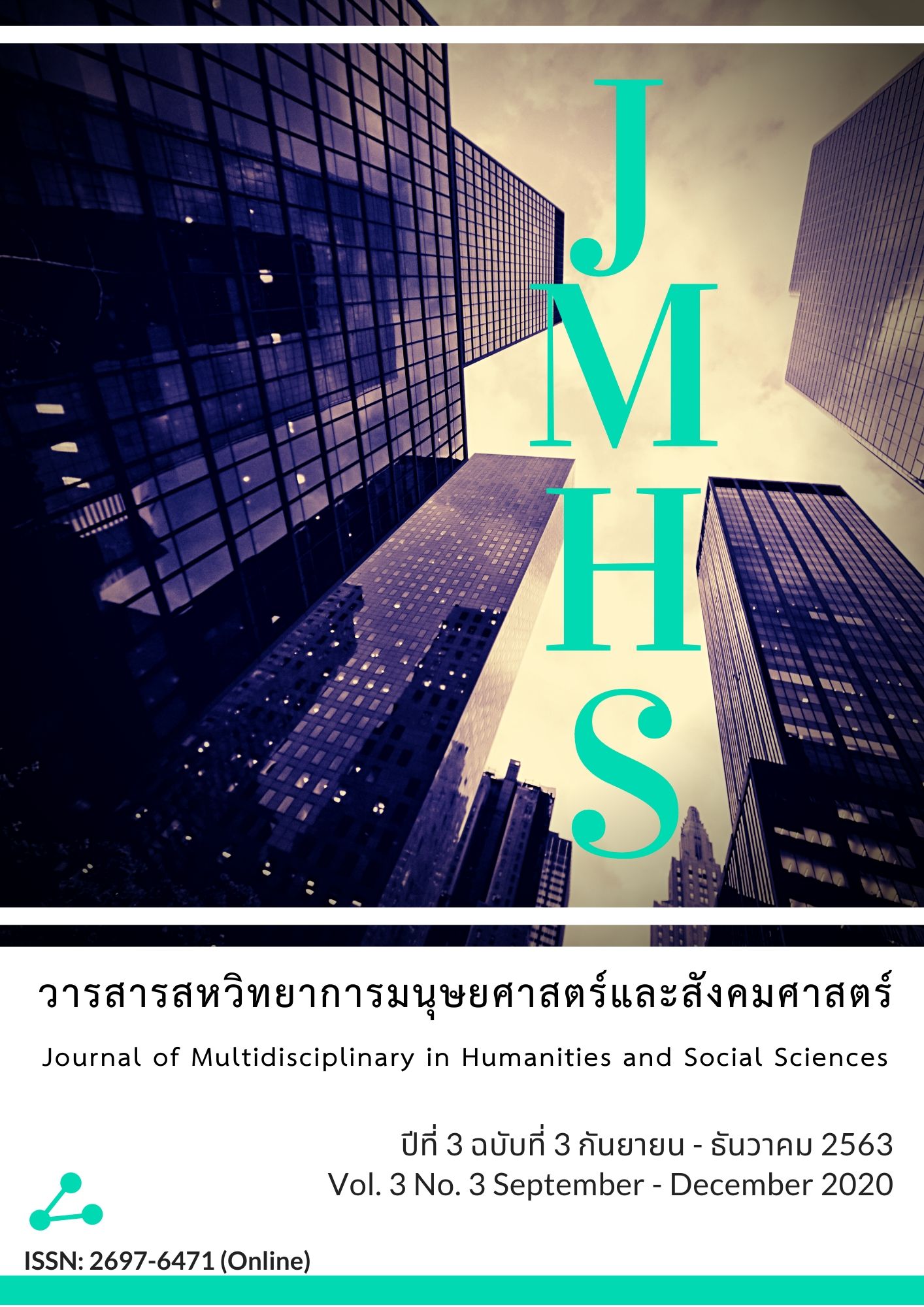The Development of English Reading Model based on Constructivism and Critical Reading Strategies to Enhance Critical Reading Abilities for Matthayomsuksa 3 Students in Educational Opportunity Expansion School
Main Article Content
Abstract
The purposes of this research were to: 1) develop and evaluate the English Reading Instructional Model based on constructivism and critical reading strategies to enhance critical reading abilities; 2) determine the results of English Reading Model based on constructivism and critical reading strategies to enhance critical reading abilities; and 3) validate the model by the other five experts. The sample was 16 students of Matthayomsuksa 3 Bantriam School, Kuraburi district, Phang-nga province, during the second semester of Academic year 2019. They were randomly selected. The data were analyzed by frequency, percentage, mean standard deviation, t-test independent and content analysis .
The research results were found as follows: 1) The English Reading Instructional Model (ESQSE Model) consists of 5 components; principle, objectives, learning procedures, evaluation and learning factors was named from the 5 steps are Engaging (E), Self-Reading (S), Questioning (Q), Sharing (S), and Evaluation (E), 2) The students’ critical reading ability scores obtained in post-test after learning by using ESQSE Model were significantly higher than pre-test at the .05 level, and 3) The ESQSE Model was verified by the other five experts at the high level.
Article Details
Views and opinions appearing in the Journal it is the responsibility of the author of the article, and does not constitute the view and responsibility of the editorial team.
References
จิรวัฒน์ เพชรรัตน์ และอัมพร ทองใบ. (2556). การอ่านและการเขียนทางวิชาการ. กรุงเทพมหานคร: โอเดียนสโตร์.
จุฑาธิป เปลาเล .(2561). การพัฒนาผลสัมฤทธิ์การอ่านอย่างมีวิจารณญาณของนักเรียนชั้นมัธยมศึกษาปีที่ 4 ที่จัดการเรียนรู้โดยใช้ปัญหาเป็นฐาน (Problem Based Learning : PBL). (ปริญญาศึกษาศาสตรมหาบัณฑิต สาขาวิชาการสอนภาษาไทย). มหาวิทยาลัยศิลปากร.
ณัฐวดี ธาตุดี. (2561). การพัฒนาความสามารถด้านการอ่านอย่างมีวิจารณญาณของนักเรียน ชั้นมัธยมศึกษาปีที่ 3 โดยการจัดกิจกรรมการเรียนรู้เชิงรุก (Active Learning). (ปริญญาศึกษาศาสตรมหาบัณฑิต สาขาวิชาการสอนภาษาไทย). มหาวิทยาลัยศิลปากร.
ดนยา วงศ์ธนะชัย. (2542). การอ่านเพื่อชีวิต. พิษณุโลก: สถาบันราชภัฎพิบูลสงคราม.
ทิศนา แขมณี. (2555). ศาสตร์การสอน: องค์ความรู้เพื่อการจัดกระบวนการเรียนรู้ที่มีประสิทธิภาพ. กรุงเทพฯ: สำนักพิมพ์แห่งจุฬาลงกรณ์มหาวิทยาลัย.
บันลือ พฤกษะวัน. (2543). แนวพัฒนา การอ่านเร็ว คิดเป็น. กรุงเทพฯ: ไทยวัฒนาพานิช.
ยุพรพรรณ ตันติสัตยานนท์. (2555). การพัฒนาโมดูลการอ่านภาษาอังกฤษธุรกิจที่เน้นจริยธรรมธุรกิจเพื่อส่งเสริมทักษะการอ่านอย่างมีวิจารณญาณและความตระหนักด้านจริยธรรมทางธุรกิจสำหรับนักศึกษามหาวิทยาลัยเทคโนโลยีราชมงคลรัตนโกสินทร์. (ปริญญาปรัชญาดุษฎีบัณฑิต สาขาวิชาหลักสูตรและการสอน). มหาวิทยาลัยศิลปากร.
สงัด อุทรานันท์. (2532). พื้นฐานและหลักการพัฒนาหลักสูตร. กรุงเทพฯ: คณะครุศาสตร์, จุฬาลงกรณ์มหาวิทยาลัย.
วิสาข์ จัติวัตร์. (2541). การสอนอ่านภาษาอังกฤษ. กรุงเทพฯ: คณะศึกษาศาสตร์, มหาวิทยาลัยศิลปากร.
เอมอร เนียมน้อย. (2551). พัฒนาการอ่านอย่างมีวิจารณญาณ. กรุงเทพฯ: สุวีริยาสาส์น.
Barnett, H. (1989). What Teachers Should Know About Their Classroom Learners. Foreign Language Annals, 22(2), 199-201.
Dick, W., Carey, L., & Carey, J. O. (2005). The Systematic Design of Instruction (6th ed.). Boston: Allyn and Bacon.
Driver, R., & Bell, B. (1986). Students' Thinking and Learning of Science: A. Constructivist View. School Science Revie, 67(240), 443-456.
Joyce, B., & Weil, M. (1999). Models of Teaching (6th ed.) Boston: Allyn and Bacon.
Koralex, D. (2012). Reading Aloud with Children of All Ages. Retrieved June 18, 2020, from http://journal.naeyc.org/btj/200303/readingaloud.pdf.
Kruse, K. (2007). Instruction to Instructional Design and the ADDIE Model. Retrieved June 18, 2020, from http//www.elearninggurn.com/articles/art1_1.htm
Naiman, N., Fröhlich, M., Stern, H. H., & Todesco, A. (1978). The good language learner (Research in Education Series No. 7). Toronto, Canada: Ontario Institute for Studies in Education.
Nuttall, C. (1996). Teaching reading skills in a foreign language. Bath: Heinemann.
Rubin, J. (1975). What the “Good Language Learner” Can Teach Us. TESOL Quarterly, 9, 41-51.
Schmitt, M. C., & Baumann, J. F. (1986). How to incorporate comprehension monitoring strategies into basal reader instruction. Reading Teacher, 40(1), 28–31.
Stern, H. H. (1975). What can we learn from the good language learner?. Canadian Modern Language Review, 34, 304-318.
Underhill, R. G. (1991). Two layers of constructivist curricular interaction. In E. von Glasersfeld (ed.), Radical Constructivist in Mathematics Education, pp. 229-248. Dordrecht, The Natherlands: Kluwer Academic.
Vygotsky, L. S. (1978). Mind in society: The development of higher psychological processes. Cambridge, MA: Harvard University Press.
Wallace, R. B. (1992). Aging and Disease: From laboratory to communication in the epidemiologic study of the elderly. New York: Oxford University Press.

